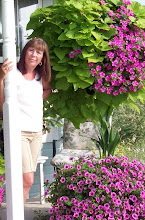 What I know about ornithology, I could fit into a thimble. I'm not an avid bird watcher either. It's just hard not to notice bright flashy feathers against the grays and browns of a winter landscape. Yesterday I was lucky enough to be in my kitchen, looking out the sliding glass door that leads to the deck when a swoosh of fire engine red took perch on the edge of a barren flower pot. A male cardinal! Spectacular. Not more than a week before, I was delighted in the same way by a male robin. The appearance of both fine feathered gentlemen made me reflect on another dapper fellow who came to visit last spring---the Baltimore oriole.
What I know about ornithology, I could fit into a thimble. I'm not an avid bird watcher either. It's just hard not to notice bright flashy feathers against the grays and browns of a winter landscape. Yesterday I was lucky enough to be in my kitchen, looking out the sliding glass door that leads to the deck when a swoosh of fire engine red took perch on the edge of a barren flower pot. A male cardinal! Spectacular. Not more than a week before, I was delighted in the same way by a male robin. The appearance of both fine feathered gentlemen made me reflect on another dapper fellow who came to visit last spring---the Baltimore oriole.Spring was going full throttle when I first noticed neon orange flashes darting past my windows. I just couldn't get a good look to determine the kind of bird because he was here and gone in an instant. Then one morning, I was sitting at the breakfast nook table when all of a sudden there he was perched on top of one of two trellises I have on my deck. I knew I had to do something to get him to want to come back and visit often. (Later I learned that we are lucky enough to be situated in the migratory path of the oriole. This path actually cuts a good swath through the US and up into Canada so a good number of Americans can actually attract this bird to their yards.) I did a little research and found that by providing the oriole with its favorite food source---oranges and grape jelly---was the key to both a morning and a late afternoon visit.
Buy a feeder which will hold both an orange half and a few tablespoons of grape jelly besides the liquid nectar. I particularly like the Classic Oriole Feeder recommended by the National Audubon Society and manufactured by WoodLink. It holds the nectar, the orange, and the jelly all in one unit. It's easy to assemble and keep clean as well. I bought mine at Colonial Nursery. Check the WoodLink site for a retailer near you. I hung the feeder from my arbor and within a few hours I had three different males fighting over it.
The oriole usually arrives in Kansas City around the first of May. Since I'm about thirty miles south, I'll put my feeder out the last week in April in anticipation of my little buddies.





